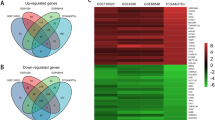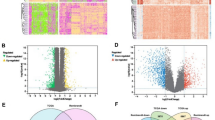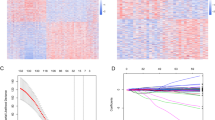Abstract
Solute carrier family 16 member 1 (SLC16A1) is a crucial transcription factor in modifying cancer progression and metastasis. However, its character in defining the clinical prognosis of human gliomas has not been illuminated. In our analysis from PREdiction of Clinical Outcomes from Genomic Profiles (PRECOG), The Cancer Genome Atlas (TCGA), and Chinese Glioma Genome Atlas (CGGA), we found that SLC16A1 mRNA expression level was significantly increased in high-grade gliomas in contrast to low-grade gliomas and non-tumor controls (P < 0.05). Kaplan–Meier analysis of four independent cohort studies from the Gene Expression Omnibus (GEO) profile, TCGA, and CGGA which consistently presented patients with high SLC16A1 mRNA expression displayed poor overall survival in high-grade glioma patients (P < 0.05 by log-rank test). Based on the Search Tool for the Retrieval of Interacting Genes/Proteins (STRING), the protein–protein interaction analysis of SLC16A1-regulated oncogenesis showed SLC16A1 as a potential hub protein. Immunohistochemical staining exhibited that SLC16A1 protein overexpressed in high-grade gliomas compared with low-grade clinical glioma samples. All these findings suggest that SLC16A1 expression has a positive correlation with WHO pathological grading and poor survival. SLC16A1 might be a potential biomarker of prognosis in human gliomas.






Similar content being viewed by others
Data Availability
The dataset used and/or analyzed during the current study are available from the corresponding author on a reasonable request.
References
Avitabile M et al (2020) Neural crest-derived tumor neuroblastoma and melanoma share 1p13.2 as susceptibility locus that shows a long-range interaction with the SLC16A1 gene. Carcinogenesis 41:284–295. https://doi.org/10.1093/carcin/bgz153
Barrett T et al (2009) NCBI GEO: archive for high-throughput functional genomic data. Nucleic Acids Res 37:D885–D890
Barrett T et al (2013) NCBI GEO: archive for functional genomics data sets--update. Nucleic Acids Res 41:D991-D995. https://doi.org/10.1093/nar/gks1193
Cerami E et al (2012) The cBio cancer genomics portal: an open platform for exploring multidimensional cancer genomics data. Cancer Discov 2:401–404. https://doi.org/10.1158/2159-8290.CD-12-0095
El-Tohamy R, Elkholi I, Elsherbiny ME, Magdy M, Hammam O, Allalunis-Turner J, Emara M (2020) Myoglobin variants are expressed in human glioblastoma cells-hypoxia effect? Oncol Rep 43:975–985. https://doi.org/10.3892/or.2020.7479
Fang J et al (2006) The H+-linked monocarboxylate transporter (MCT1/SLC16A1): a potential therapeutic target for high-risk neuroblastoma. Mol Pharmacol 70:2108–2115. https://doi.org/10.1124/mol.106.026245
Gentles AJ et al (2015) The prognostic landscape of genes and infiltrating immune cells across human cancers. Nat Med 21:938–945. https://doi.org/10.1038/nm.3909
Ghosh D et al (2017) A cell-surface membrane protein signature for glioblastoma. Cell Syst 4:516-529.e517. https://doi.org/10.1016/j.cels.2017.03.004
Ghosh D et al (2016) TGFβ-responsive HMOX1 expression is associated with stemness and invasion in glioblastoma multiforme. Stem Cells 34:2276–2289. https://doi.org/10.1002/stem.2411
Gravendeel LA et al (2009) Intrinsic gene expression profiles of gliomas are a better predictor of survival than histology. Cancer Res 69:9065–9072. https://doi.org/10.1158/0008-5472.CAN-09-2307
Hou L et al (2019) Interfering cellular lactate homeostasis overcomes Taxol resistance of breast cancer cells through the microRNA-124-mediated lactate transporter (MCT1) inhibition. Cancer Cell Int 19:193. https://doi.org/10.1186/s12935-019-0904-0
Hueng DY et al (2015) DDX3X biomarker correlates with poor survival in human gliomas. Int J Mol Sci 16:15578–15591. https://doi.org/10.3390/ijms160715578
Karar J, Maity A (2011) PI3K/AKT/mTOR pathway in angiogenesis. Front Mol Neurosci 4:51. https://doi.org/10.3389/fnmol.2011.00051
Lacina P, Butrym A, Mazur G, Bogunia-Kubik K (2018) BSG and MCT1 genetic variants influence survival in multiple myeloma patients. Genes (Basel) 9:226. https://doi.org/10.3390/genes9050226
Lean CB, Lee EJ (2009) Genetic variations in the MCT1 (SLC16A1) gene in the Chinese population of Singapore. Drug Metab Pharmacokinet 24:469–474. https://doi.org/10.2133/dmpk.24.469
Liu HY et al (2020) lncRNA SLC16A1-AS1 as a novel prognostic biomarker in non-small cell lung cancer. J Investig Med 68:52–59. https://doi.org/10.1136/jim-2019-001080
Muramatsu T (2016) Basigin (CD147), a multifunctional transmembrane glycoprotein with various binding partners. J Biochem 159:481–490. https://doi.org/10.1093/jb/mvv127
Murray CM et al (2005) Monocarboxylate transporter MCT1 is a target for immunosuppression. Nat Chem Biol 1:371–376. https://doi.org/10.1038/nchembio744
Payen VL, Mina E, Van Hee VF, Porporato PE, Sonveaux P (2020) Monocarboxylate transporters in cancer. Mol Metab 33:48–66. https://doi.org/10.1016/j.molmet.2019.07.006
Phillips HS et al (2006) Molecular subclasses of high-grade glioma predict prognosis, delineate a pattern of disease progression, and resemble stages in neurogenesis. Cancer Cell 9:157–173. https://doi.org/10.1016/j.ccr.2006.02.019
Schulte A et al (2011) A distinct subset of glioma cell lines with stem cell-like properties reflects the transcriptional phenotype of glioblastomas and overexpresses CXCR4 as therapeutic target. Glia 59:590–602. https://doi.org/10.1002/glia.21127
Stupp R et al (2005) Radiotherapy plus concomitant and adjuvant temozolomide for glioblastoma. N Engl J Med 352:987–996. https://doi.org/10.1056/NEJMoa043330
Szklarczyk D et al (2019) STRING v11: protein-protein association networks with increased coverage, supporting functional discovery in genome-wide experimental datasets. Nucleic Acids Res 47:D607-D613. https://doi.org/10.1093/nar/gky1131
Tiemeier GL et al (2020) Lowering the increased intracellular pH of human-induced pluripotent stem cell-derived endothelial cells induces formation of mature Weibel-Palade bodies. Stem Cells Transl Med 9:758–772. https://doi.org/10.1002/sctm.19-0392
Tsai WC et al (2013) EMMPRIN expression positively correlates with WHO grades of astrocytomas and meningiomas. J Neurooncol 114:281–290. https://doi.org/10.1007/s1106001311845
Zhao Z et al (2020) Chinese Glioma Genome Atlas (CGGA): a comprehensive resource with functional genomic data for Chinese glioma patients bioRxiv:2020.2001.2020.911982. https://doi.org/10.1101/2020.01.20.911982
Acknowledgements
The authors acknowledge Chin Lin for statistical analyses.
Funding
This study was supported in part by grants from Taichung Armed Force General Hospital (108B03, TCAFGH-E-109049 to K.-C.H), the Ministry of Science and Technology (MOST 106–2314-B-016–012-MY3 and MOST 108–2314-B-016–026 -MY3 to D.-Y.H.), Tri-Service General Hospital (TSGH-C108-007–008-S05 and TSGH-C01-109016 to D.-Y.H), and Medical Affairs Bureau, Ministry of National Defense (MAB-106–019, MAB-107–009, MAB-108–022 and MAB-109–014 to D.-Y.H).
Author information
Authors and Affiliations
Contributions
Conceptualization: Hong-Han Lin, Dueng-Yuan Hueng and Kuang-Chen Hung; Data curation, Hong-Han Lin, Chia-Kuang Tsai, Ssu-Han Chen, Li-Chun Huang, Dueng-Yuan Hueng, and Kuang-Chen Hung. Formal analysis, Hong-Han Lin, Wen-Chiuan Tsai, Ssu-Han Chen, Li-Chun Huang, Dueng-Yuan Hueng, and Kuang-Chen Hung. Funding acquisition, Dueng-Yuan Hueng and Kuang-Chen Hung. Investigation, Hong-Han Lin, Chia-Kuang Tsai, Ssu-Han Chen, Dueng-Yuan Hueng, and Kuang-Chen Hung. Methodology, Hong-Han Lin, Wen-Chiuan Tsai, Ssu-Han Chen, Li-Chun Huang, Dueng-Yuan Hueng, and Kuang-Chen Hung. Project administration, Dueng-Yuan Hueng, and Kuang-Chen Hung. Resources, Wen-Chiuan Tsai and Kuang-Chen Hung. Software, Hong-Han Lin, and Wen-Chiuan Tsai. Supervision, Dueng-Yuan Hueng, and Kuang-Chen Hung, Validation, Hong-Han Lin, Chia-Kuang Tsai, Li-Chun Huang, Dueng-Yuan Hueng, and Kuang-Chen Hung. Writing—original draft, Hong-Han Lin. Writing—review & editing, Hong-Han Lin, Dueng-Yuan Hueng, and Kuang-Chen Hung.
Corresponding authors
Ethics declarations
Ethics Approval
This study was approved by the ethics Committee of Tri-Service General Hospital, National Defense Medical Center, Taipei, Taiwan, ROC (TSGHIRB No: B-102–10).
Consent for Publication
All of the authors signed the consent for publication of this study.
Conflict of Interest
The authors declare that they have no conflict of interest.
Additional information
Publisher’s Note
Springer Nature remains neutral with regard to jurisdictional claims in published maps and institutional affiliations.
Rights and permissions
About this article
Cite this article
Lin, HH., Tsai, WC., Tsai, CK. et al. Overexpression of Cell-Surface Marker SLC16A1 Shortened Survival in Human High-Grade Gliomas. J Mol Neurosci 71, 1614–1621 (2021). https://doi.org/10.1007/s12031-021-01806-w
Received:
Accepted:
Published:
Issue Date:
DOI: https://doi.org/10.1007/s12031-021-01806-w




